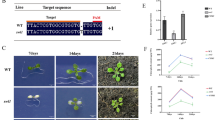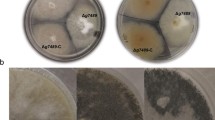Abstract
The evolutionarily conserved serine/threonine kinase TOR recruits different subunits to assemble the Target of Rapamycin Complex 1 (TORC1), which is inhibited by rapamycin and regulates ribosome biogenesis, autophagy, and lipid metabolism by regulating the expression of lipogenic genes. In addition, TORC1 participates in the cell cycle, increasing the length of the G2 phase. In the present work, we investigated the effect of rapamycin on cell growth, cell morphology and neutral lipid metabolism in the phytopathogenic fungus Ustilago maydis. Inhibition of TORC1 by rapamycin induced the formation of septa that separate the nuclei that were formed after mitosis. Regarding neutral lipid metabolism, a higher accumulation of triacylglycerols was not detected, but the cells did contain large lipid bodies, which suggests that small lipid bodies became fused into big lipid droplets. Vacuoles showed a similar behavior as the lipid bodies, and double labeling with Blue-CMAC and BODIPY indicates that vacuoles and lipid bodies were independent organelles. The results suggest that TORC1 has a role in cell morphology, lipid metabolism, and vacuolar physiology in U. maydis.






Similar content being viewed by others
References
Aguilar LR, Pardo JP, Lomeli MM, Bocardo OIL, Juarez Oropeza MA, Sanchez GG (2017) Lipid droplets accumulation and other biochemical changes induced in the fungal pathogen Ustilago maydis under nitrogen-starvation. Arch Microbiol 199:1195–1209
Banuett F, Herskowitz I (1989) Different a alleles of Ustilago maydis are necessary for maintenance of filamentous growth but not for meiosis. Proc Natl Acad Sci USA 86:5878–5882
Barquilla A, Crespo JL, Navarro M (2008) Rapamycin inhibits trypanosome cell growth by preventing TOR complex 2 formation. Proc Natl Acad Sci USA 105:14579–14584
Betz C, Hall MN (2013) Where is mTOR and what is it doing there? J Cell Biol 203:563–574
Bracharz F, Redai V, Bach K, Qoura F, Bruck T (2017) The effects of TORC signal interference on lipogenesis in the oleaginous yeast Trichosporon oleaginosus. BMC Biotechnol 17:27
Brefort T, Doehlemann G, Mendoza-Mendoza A, Reissmann S, Djamei A, Kahmann R (2009) Ustilago maydis as a pathogen. Annu Rev Phytopathol 47:423–445
Cardenas ME, Heitman J (1995) FKBP12-rapamycin target TOR2 is a vacuolar protein with an associated phosphatidylinositol-4 kinase activity. EMBO J 14:5892–5907
Cardenas ME, Cutler NS, Lorenz MC, Di Como CJ, Heitman J (1999) The TOR signaling cascade regulates gene expression in response to nutrients. Genes Dev 13:3271–3279
Cornu M, Albert V, Hall MN (2013) mTOR in aging, metabolism, and cancer. Curr Opin Genet Dev 23:53–62
Cutler NS, Pan X, Heitman J, Cardenas ME (2001) The TOR signal transduction cascade controls cellular differentiation in response to nutrients. Mol Biol Cell 12:4103–4113
Dementhon K, Paoletti M, Pinan-Lucarre B, Loubradou-Bourges N, Sabourin M, Saupe SJ, Clave C (2003) Rapamycin mimics the incompatibility reaction in the fungus Podospora anserina. Eukaryot Cell 2:238–246
Du W, Halova L, Kirkham S, Atkin J, Petersen J (2012) TORC2 and the AGC kinase Gad8 regulate phosphorylation of the ribosomal protein S6 in fission yeast. Biol Open 1:884–888
Durrenberger F, Wong K, Kronstad JW (1998) Identification of a cAMP-dependent protein kinase catalytic subunit required for virulence and morphogenesis in Ustilago maydis. Proc Natl Acad Sci USA 95:5684–5689
Evans SK, Burgess KE, Gray JV (2014) Recovery from rapamycin: drug-insensitive activity of yeast target of rapamycin complex 1 (TORC1) supports residual proliferation that dilutes rapamycin among progeny cells. J Biol Chem 289:26554–26565
Freitag J, Lanver D, Bohmer C, Schink KO, Bolker M, Sandrock B (2011) Septation of infectious hyphae is critical for appressoria formation and virulence in the smut fungus Ustilago maydis. PLoS Pathog 7:e1002044
Fuchs U, Hause G, Schuchardt I, Steinberg G (2006) Endocytosis is essential for pathogenic development in the corn smut fungus Ustilago maydis. Plant Cell 18:2066–2081
Garcia-Pedrajas MD, Baeza-Montanez L, Gold SE (2010) Regulation of Ustilago maydis dimorphism, sporulation, and pathogenic development by a transcription factor with a highly conserved APSES domain. Mol Plant Microbe Interact 23:211–222
Gaubitz C, Prouteau M, Kusmider B, Loewith R (2016) Torc2 structure and function. Trends Biochem Sci 41:532–545
Goberdhan DCI, Wilson C, Harris AL (2016) Amino acid sensing bymTORC1: intracellular transporters mark the spot. Cell Metab 23:580–589
Gonzalez S, Rallis C (2017) The TOR signaling pathway in spatial and temporal control of cell size and growth. Front Cell Dev Biol 5:61
Guri Y, Colombi M, Dazert E et al (2017) mTORC2 promotes tumorigenesis via lipid synthesis. Cancer Cell 32:807–823
Hallett JEH, Luo X, Capaldi AP (2014) State transitions in the TORC1 signaling pathway and information processing in Saccharomyces cerevisiae. Genetics 198:773–786
Hartmuth S, Petersen J (2009) Fission yeast Tor1 functions as part of TORC1 to control mitotic entry through the stress MAPK pathway following nutrient stress. J Cell Sci 122:1737–1746
Ikai N, Nakazawa N, Hayashi T, Yanagida M (2011) The reverse, but coordinated, roles of Tor2 (TORC1) and Tor1 (TORC2) kinases for growth, cell cycle and separase-mediated mitosis in Schizosaccharomyces pombe. Open Biol 1(3):110007
Kamper J, Kahmann R, Bolker M et al (2006) Insights from the genome of the biotrophic fungal plant pathogen Ustilago maydis. Nature 444:97–101
Kapahi P, Chen D, Rogers AN, Katewa SD, Li PWL, Thomas EL, Kockel L (2010) With TOR, less is more: a key role for the conserved nutrient-sensing TOR pathway in aging. Cell Metab 11:453–465
Kellner N, Heimel K, Obhof T, Finkernagel F, Kamper J (2014) The SPF27 homologue Num1 connects splicing and kinesin 1-dependent cytoplasmic trafficking in Ustilago maydis. PLoS Genet 10:e1004046
Laplante M, Sabatini DM (2009) mTOR signaling at a glance. J Cell Sci 122:3589–3594
Laxman S, Tu BP (2011) Multiple TORC1-associated proteins regulate nitrogen starvation-dependent cellular differentiation in Saccharomyces cerevisiae. PLoS ONE 6:e26081
Leskoske KL, Roelants FM, Marshall MNM, Hill JM, Thorner J (2017) The stress-sensing TORC2 complex activates yeast AGC-family protein kinase Ypk1 at multiple novel sites. Genetics 207:179–195
Li J, Kim SG, Blenis J (2014a) Rapamycin: one drug, many effects. Cell Metab 19:373–379
Li J, Kim SG, Blenis J (2014b) Rapamycin: one drug, many effects. Cell Metab 19:373–379
Loewith R, Hall MN (2011) Target of rapamycin (TOR) in nutrient signaling and growth control. Genetics 189:1177–1201
Madeira JB, Masuda CA, Maya-Monteiro CM, Matos GS, Montero-Lomeli M, Bozaquel-Morais BL (2015) TORC1 inhibition induces lipid droplet replenishment in yeast. Mol Cell Biol 35:737–746
Manning BD (2017) Game of TOR—the target of rapamycin rules four kingdoms. N Engl J Med 377:1297–1299
Matsuo T, Otsubo Y, Urano J, Tamanoi F, Yamamoto M (2007) Loss of the TOR kinase Tor2 mimics nitrogen starvation and activates the sexual development pathway in fission yeast. Mol Cell Biol 27:3154–3164
Noda T (2017) Regulation of autophagy through TORC1 and mTORC1. Biomolecules 7(3):52
Orlova M, Kanter E, Krakovich D, Kuchin S (2006) Nitrogen availability and TOR regulate the Snf1 protein kinase in Saccharomyces cerevisiae. Eukaryot Cell 5:1831–1837
Otsubo Y, Yamamato M (2008) TOR signaling in fission yeast. Crit Rev Biochem Mol Biol 43:277–283
Otsubo Y, Nakashima A, Yamamoto M, Yamashita A (2017) TORC1-dependent phosphorylation targets in fission yeast. Biomolecules 7(3):50
Perez-Hidalgo L, Moreno S (2017) Coupling TOR to the cell cycle by the greatwall-endosulfine-PP2A-B55 pathway. Biomolecules 7(3):59
Pham CD, Yu Z, Sandrock B, Bolker M, Gold SE, Perlin MH (2009) Ustilago maydis Rho1 and 14-3-3 homologues participate in pathways controlling cell separation and cell polarity. Eukaryot Cell 8:977–989
Rallis C, Codlin S, Bahler J (2013) TORC1 signaling inhibition by rapamycin and caffeine affect lifespan, global gene expression, and cell proliferation of fission yeast. Aging Cell 12:563–573
Roelofs J, Waite KA, Vontz G, De la Mota-Peynado A (2017) Nitrogen starvation and rapamycin both induce autophagic degradation of proteasome complexes. FASEB J 31:917.916
Russell RC, Fang C, Guan KL (2011) An emerging role for TOR signaling in mammalian tissue and stem cell physiology. Development 138:3343–3356
Saavedra E, Ramos-Casillas LE, Marin-Hernandez A, Moreno-Sanchez R, Guerra-Sanchez G (2008) Glycolysis in Ustilago maydis. FEMS Yeast Res 8:1313–1323
Saldivia M, Barquilla A, Bart JM, Diaz-Gonzalez R, Hall MN, Navarro M (2013) Target of rapamycin (TOR) kinase in Trypanosoma brucei: an extended family. Biochem Soc Trans 41:934–938
Sartorel E, Perez-Martin J (2012) The distinct interaction between cell cycle regulation and the widely conserved morphogenesis-related (MOR) pathway in the fungus Ustilago maydis determines morphology. J Cell Sci 125:4597–4608
Schneider CA, Rasband WS, Eliceiri KW (2012) NIH Image to ImageJ: 25 years of image analysis. Nat Methods 9:671–675
Soberanes-Gutierrez CV, Juarez-Montiel M, Olguin-Rodriguez O, Hernandez-Rodriguez C, Ruiz-Herrera J, Villa-Tanaca L (2015) The pep4 gene encoding proteinase A is involved in dimorphism and pathogenesis of Ustilago maydis. Mol Plant Pathol 16:837–846
Stevenson K, McVey AF, Clark IBN, Swain PS, Pilizota T (2016) General calibration of microbial growth in microplate readers. Sci Rep 6:38828
Takahara T, Maeda T (2012) TORC1 of fission yeast is rapamycin-sensitive. Genes Cells 17:698–708
Tatebe H, Shiozaki K (2017) Evolutionary conservation of the components in the TOR signaling pathways. Biomolecules 7(4):77
Teter SA, Klionsky DJ (2000) Transport of proteins to the yeast vacuole: autophagy, cytoplasm-to-vacuole targeting, and role of the vacuole in degradation. Semin Cell Dev Biol 11:173–179
Thompson JD, Gibson TJ, Plewniak F, Jeanmougin F, Higgins DG (1997) The CLUSTAL_X windows interface: flexible strategies for multiple sequence alignment aided by quality analysis tools. Nucleic Acids Res 25:4876–4882
Vevea JD, Garcia EJ, Chan RB et al (2015) Role for lipid droplet biogenesis and microlipophagy in adaptation to lipid imbalance in yeast. Dev Cell 35:584–599
Weisman R (2004) The fission yeast tor proteins and the rapamycin response: an unexpected tale. In: Thomas G, Sabatini DM, Hall MN (eds) TOR: Target of rapamycin. Springer Berlin Heidelberg, Berlin, pp 85–95
Weisman R, Cohen A, Gasser SM (2014) TORC2-a new player in genome stability. Embo Mol Med 6:995–1002
Wullschleger S, Loewith R, Hall MN (2006) TOR signaling in growth and metabolism. Cell 124:471–484
Zavala-Moreno A, Arreguin-Espinosa R, Pardo JP, Romero-Aguilar L, Guerra-Sánchez G (2014) nitrogen source affects glycolipid production and lipid accumulation in the phytopathogen fungus Ustilago maydis. Adv Microbiol 4:934–944
Acknowledgements
This research was supported by the Universidad Nacional Autónoma de México, Programa de Apoyo a Proyectos de Investigación Tecnológica PAPIIT IN222117; Consejo Nacional de Ciencia y Tecnología CONACYT 254904-JPP and 256520-GGS; Instituto Politécnico Nacional-Secretaria de Investigación y Posgrado IPN-SIP-20180625. We thank Universidad Nacional Autónoma de México, Programa de Becas Posdoctorales en la UNAM POSDOC-Dirección General de Asuntos del Personal Académico DGAPA–UNAM for the fellowship granted to Lucero Romero–Aguilar. We thank QFB. Oscar Ivan Luqueño–Bocardo for technical assistance, and Dr. Jorge Guevara Fonseca for the equipment provided.
Author information
Authors and Affiliations
Contributions
LRA conceptualized the idea, performed microbiological experiments, FACS analysis, wrote and reviewed the manuscript. JPP conceptualized and coordinated the research, analyzed bioinformatics data, wrote the manuscript and provided funding to support the research. GGS analyzed the results, provided funding to support the research, reviewed and corrected the manuscript. GMO performed bioinformatics analysis, microbiological experiments, reviewed and corrected the manuscript. MTR performed confocal microscopy. EPT performed FACS analysis, reviewed and corrected the manuscript. OFH reviewed and corrected the manuscript. JG performed microbiological experiments, reviewed and corrected the manuscript.
Corresponding author
Additional information
Communicated by Erko Stackebrandt.
Publisher's Note
Springer Nature remains neutral with regard to jurisdictional claims in published maps and institutional affiliations.
Electronic supplementary material
Below is the link to the electronic supplementary material.
203_2020_1833_MOESM1_ESM.pdf
Pairwise sequence alignment of Tor amino acid sequences from Saccharomyces cerevisiae and Ustilago maydis. Alignment was performed with Clustal W
203_2020_1833_MOESM2_ESM.pdf
Pairwise sequence alignment of Tor amino acid sequences from Homo sapiens and Ustilago maydis. Alignment was performed with Clustal W
203_2020_1833_MOESM3_ESM.mp4
3D reconstruction of cells labeled with Blue-CMAC and BODIPY. XYZ capture was done accordingly with the Nyquist-Shannon sampling theorem and was reconstructed with NIS Elements v5.0 software. FB2 yeast cells were cultured during 24 hours in minimal medium lacking a nitrogen 674 source.
203_2020_1833_MOESM4_ESM.docx
Components of the Greatwall-Endosulfine, TORC1, and cell cycle pathways, in U. maydis. A BLASTp was carried out using S. pombe amino acid sequences as queries
Rights and permissions
About this article
Cite this article
Romero-Aguilar, L., Guerra-Sánchez, G., Tenorio, E.P. et al. Rapamycin induces morphological and physiological changes without increase in lipid content in Ustilago maydis. Arch Microbiol 202, 1211–1221 (2020). https://doi.org/10.1007/s00203-020-01833-y
Received:
Revised:
Accepted:
Published:
Issue Date:
DOI: https://doi.org/10.1007/s00203-020-01833-y




